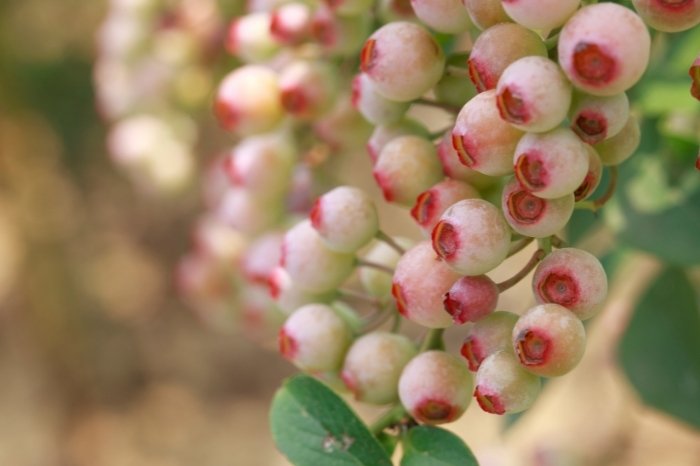Last Updated on January 10, 2022 by Cristina
The best time to plant blueberries is a must-know for every gardener who is looking to grow these berries.
Blueberries are one of the easiest fruits that anyone can draw. They can also grow organically, making them a perfect fruit tree for your backyard.
These fruits are one of the best nature superfoods loaded with essential nutrients like vitamin C and K, Manganese, and health-boosting polyphenols. If you want to include this fruit in your garden, it is best to learn of its planting season to reap a good harvest.
Blueberries thrive in temperate climates, and their growth habits are strongly seasonal. Depending on the variety you choose to grow and the region you are in, blueberries can either be planted in the fall or spring.
The Best Time To Plant Blueberries
When do you plant blueberries? – During the fall or the spring?
Fall Planting
Most experts recommend planting blueberries in the early spring or the fall as your preferred planting time. If you choose to plant blueberries in The fall, you should do it in late September or early October. The roots of your bushes will continue to grow until the soil reaches temperatures of 45 degrees Fahrenheit.
The most significant advantage of planting in the fall is that your blueberries are ready when the spring rains arrive. Usually, wet weather delays spring planting of blueberries; planted in the fall; they are already established and enjoy the best spring growth, which makes a difference between the two seasons.

If you choose to plant blueberries in the fall, your bushes should be in the ground and mulched before the beginning of winter. This is especially in areas that experience heavy frost. Whatever USDA planting zone you are in, it is vital to check the first frost date as per your zone.
Click here to Learn About:
Spring Planting
Planting your blueberry bushes in the spring allows your plants to begin growing in keeping with the natural seasonal patterns. Before planting, wait until the ground has warmed and there’s no more danger of frost.
When you plant blueberries in the spring, you will have the best chance of establishing them before winter. However, be aware that spring planting is commonly delayed by rain. Plant your blueberries as soon as the danger of frost has passed. The last frost date differs from one zone to another, and it is essential to know when your last frost date is happening.
Blueberries Varieties You Can Plant At The Right Time
Blueberries are partially self-fertile, so you will get larger berries if you plant two or more varieties together. Planting more than one variety also extends your harvesting season, giving you more fruit.
Here are several varieties you can choose from and the zones they grow in.
The High Bush
- This is a 6 ft shrub that grows in USDA zones 4 to 7.
- If you want a variety that withstands cold winters choose Blu-ray, Blue crop, Meander, or Herbert Jersey.
- Choose Darrow, Herbert, Blu-ray, Ivanhoe, Stanley, pioneer, or Wareham for flavorful berries.
- Choose Blu-ray, Blue crop, Berkeley, Herbert, coville, or Darrow for big bellies.
- If you want something different from the ordinary, try pink lemonade that produces bright pink blueberries.
Bushel and Berry – Vaccinium Pink Icing (Blueberry) Edible-Shrub
The Low Bush
This variety is best for the coldest climate and USDA hardiness zones from zone 3 to 7.
The low Bush variety are the bears you find commonly on supermarket shelves. When fresh, these fruits are sweet and covered with a thick waxy bloom that makes the berries appear grey or sky blue.
This variety has creeping plants that grow up to a foot or so high and spread by underground stems or rhizomes. They thrive in the rocky upland soils of the North East and make an excellent ornamental fruiting ground cover.
The Half High
The half-high variety results from the highbush and lowbush blueberries producing this hybrid known as the half-high blueberries.
This variety includes the North country variety that grows 18 to 24 inches high with excellent mild-flavored slightly aromatic sky blue fruits. The North blue variety grows up to 20 to 30 inches high, producing an abundance of dark blue nickel-sized fruits that are best for making pies. The Northland variety grows up to 3 to 4 feet tall and has relatively bland fruit.
The Best Blueberries For Southern Gardens In Zone 7 To 9
- Southern highbush. The south highbush varieties tend to be harder and pick here to grow. Among these varieties are the winter emerald and spring high, which are high-quality varieties.
- Rabbiteye. This variety grows in the Southern Eastern United States, and it is exceptionally adaptable, productive, and pest tolerant. However, it has a high degree of self-incompatibility and requires two or more varieties to be planted together to help pollinate. Recommended types include the Woodard, Powder Blue, and Brightwell.

Read more about Are Polka Dot Plants Perennials? – A Quick Look
How To Plant Blueberries At The Right Time
Now that we know when to plant blueberries, it is also essential to learn how to plant them.
First, select your ideal blueberry spot. Select a sunny location with well-worked rich soil that drains quickly. Avoid planting your blueberries near trees that can block out sunlight and suck the moisture in the soil. Plant your blueberries in an area with enough water to keep their roots moist throughout the growing season. You can use raised beds or patio containers if you do not have the best soils.
Second, prepare your soil. Soil preparation is essential to your blueberry plant’s health. They prefer acidic soil, and you can adjust accordingly; if your soil is not acidic enough, if you have no idea how to do it, you can consult your local garden center for an extension officer. Plan if possible to change your soil’s pH levels before planting. You can amend them as early as a year before planting your blueberries.
Third, plant your blueberries according to the proper spacing. Plant your blueberries in The fall or spring as close as two or 2.5 feet apart to form solid hedgerows. You can also space them up to six feet apart, so they grow individually. If you plant them in rows, allow at least 8 to 10 ft between the rows.
Fourth, fertilize your blueberry plants. Blueberry plants respond well to acidic fertilizers for azalea or rhododendron formulation. Be sure to follow the instructions for the fertilizer are blueberries sensitive to over-fertilization. Apply your fertilizer one month after planting and not at the planting time. Fertilize your plants once in early spring and late spring for best results. Ensure that you water them thoroughly afterward.
Fifth, mulch your blueberry plants. Blueberries thrive and are provided with at least two to four inches of mulch over the roots to conserve moisture add organic matter, and prevent weeds. Acid compost bark mulch, sawdust, or grass clippings work well.
Conclusion
Blueberries are still offered to a loved one in Ireland to commemorate the original fertility festival of laminas day celebrated on August 1st.
When to plant blueberry is always the first sign of success in growing your blueberries. There are also a variety of recipes to make using both fresh and dried blueberries.
Caroline is a gardener who loves to get down to the nitty–gritty of gardening. She proudly proclaims herself as a ‘dirt worshipper‘ and can often be found deep in the garden, covered in soil and singing to her plants. As a self–proclaimed ‘plant whisperer‘, Caroline believes that plants need love and attention just like any other living thing, and she loves to give them both. When she‘s not tending to her garden, you can often find her researching the latest gardening trends, or teaching others how to make their gardens thrive



